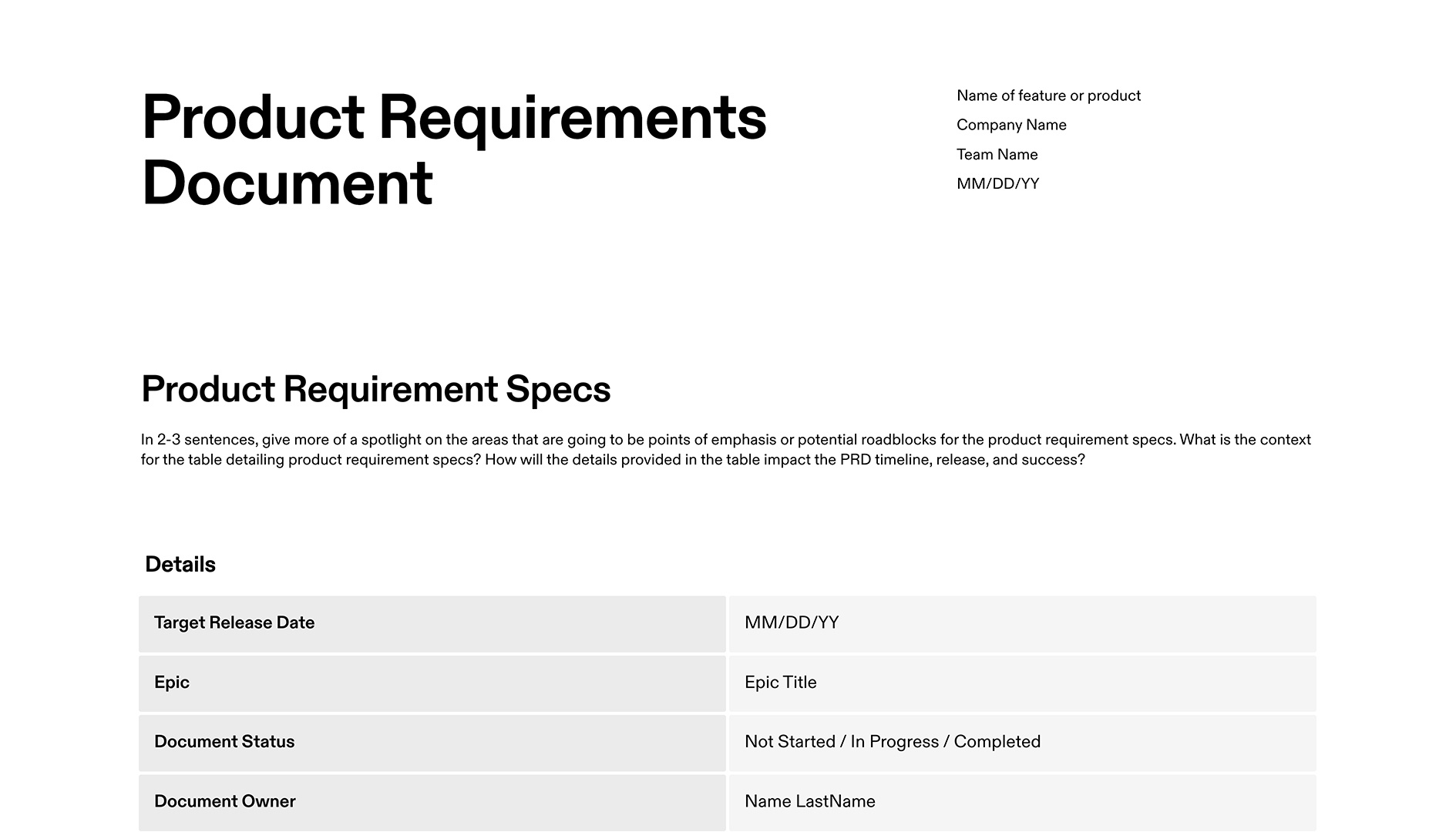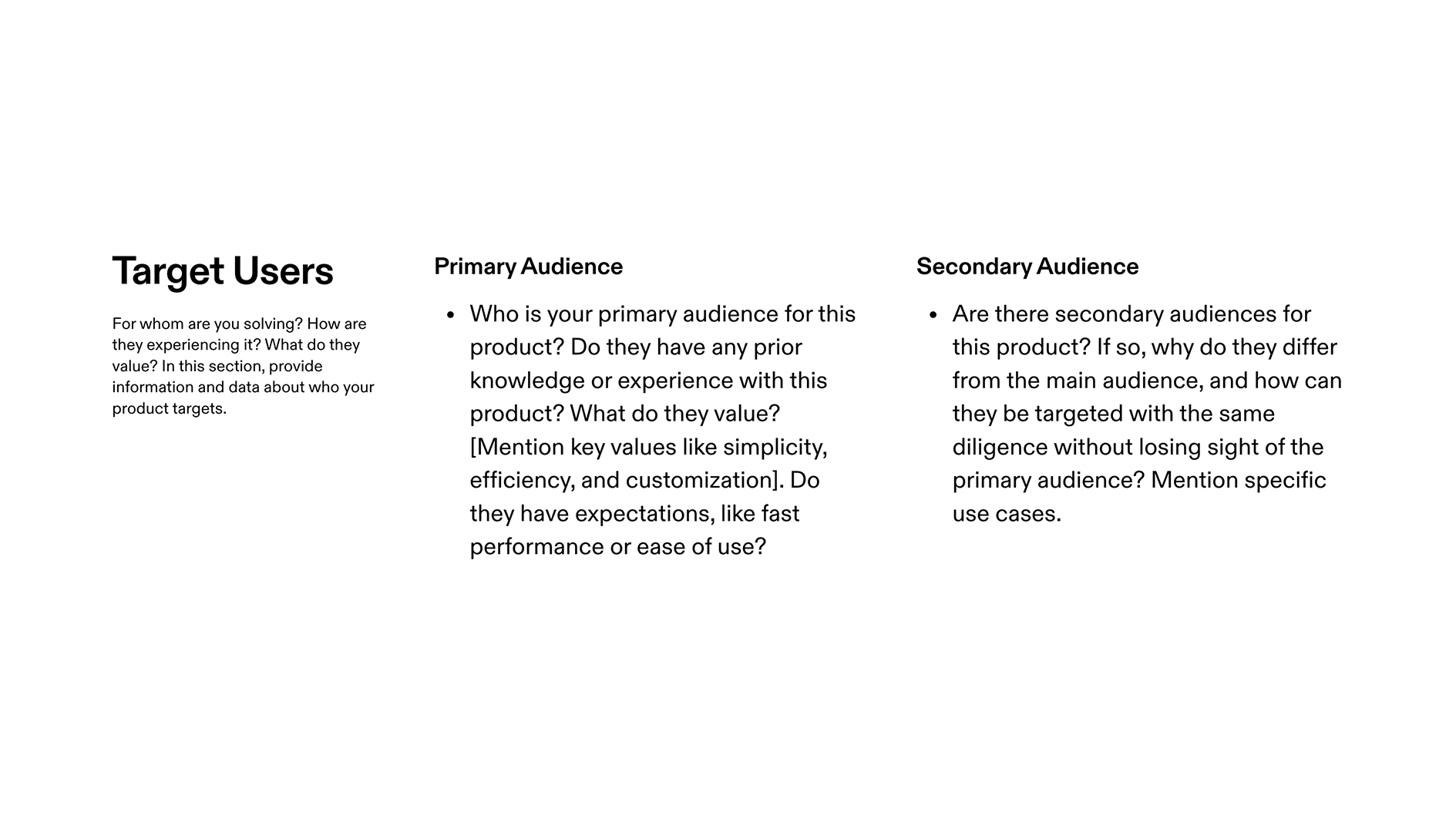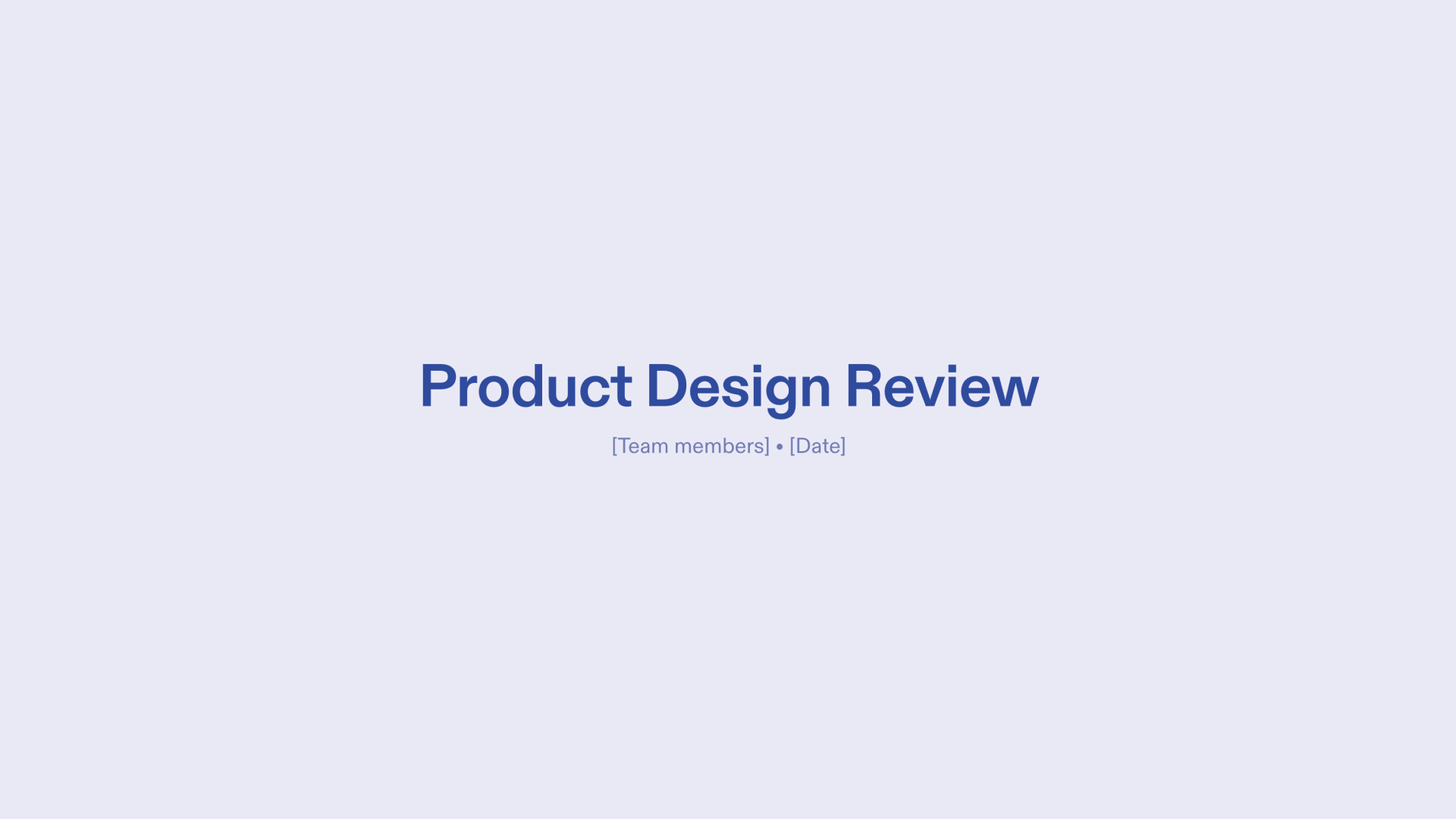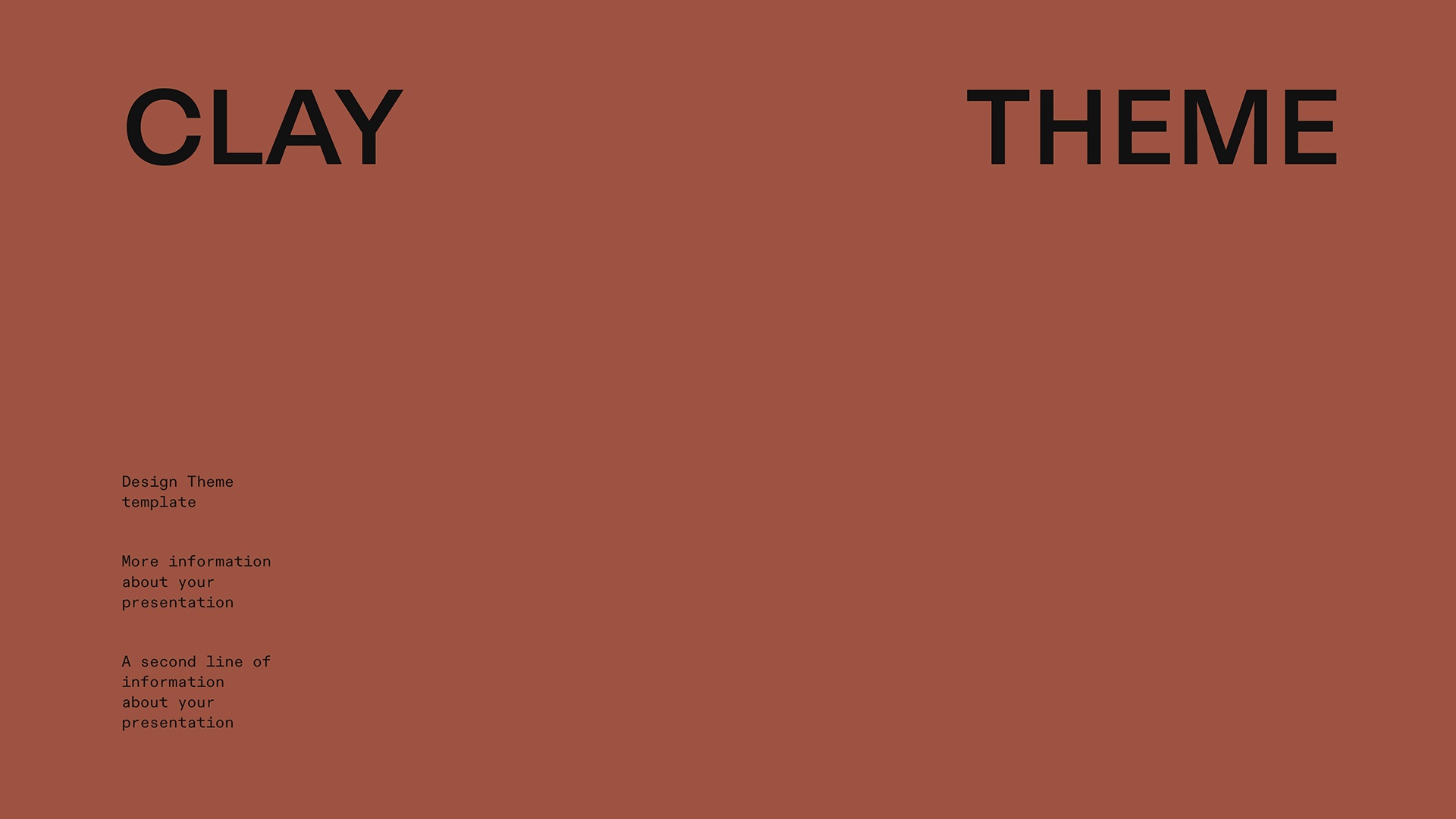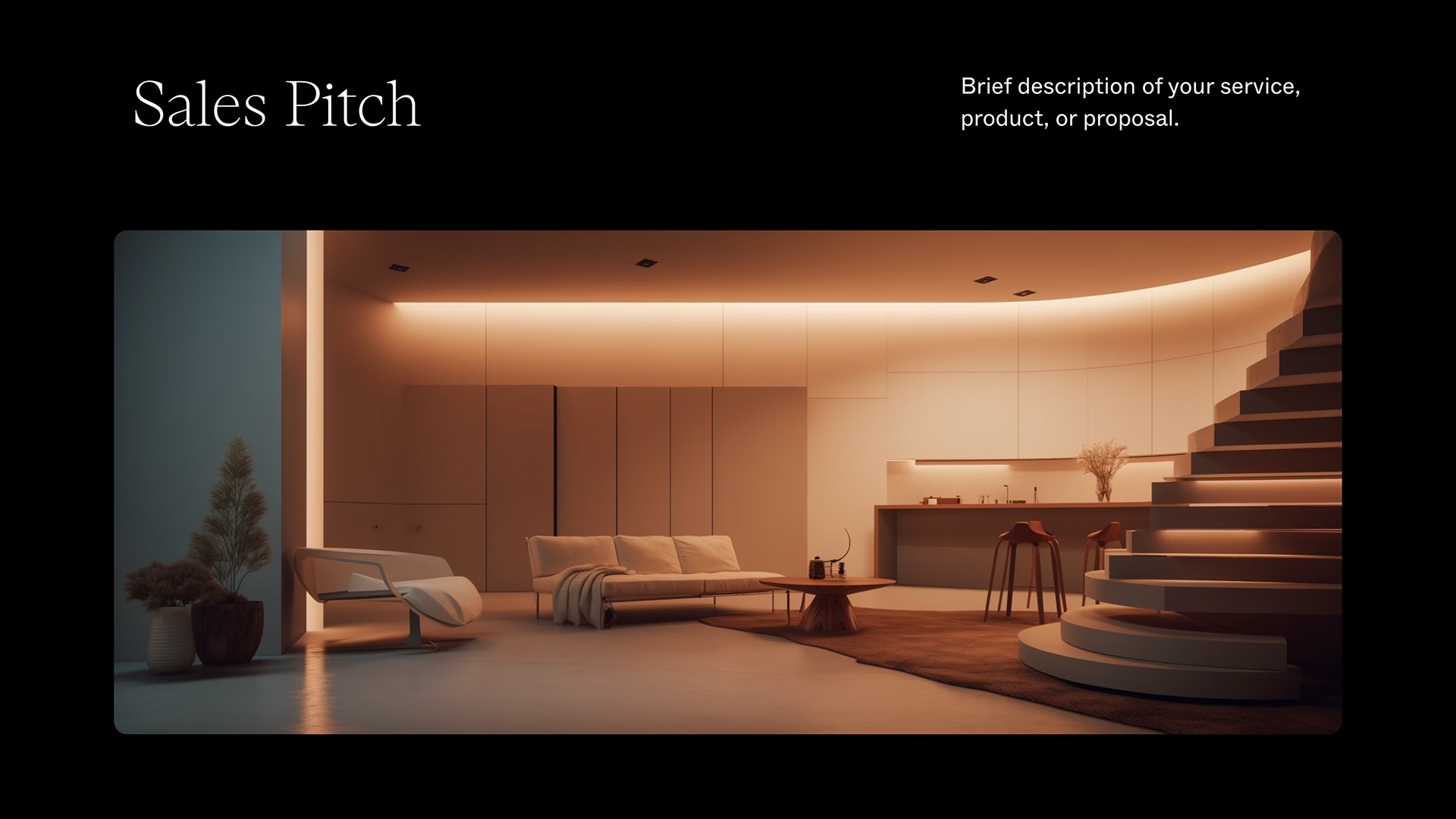Product Requirements Document
For product managers looking for buy-in from key stakeholders, Tome’s Product Requirements Document lets you present your vision from the ground up.
About this template
This product requirements document template is designed to cover every detail about how you’ll bring a new product to life. Fill in the product requirement specs, target audience, assumptions about user behavior, objectives, goals, and milestones. Help them envision this product in the real world by detailing high-importance needs of hypothetical users. Plan out a go-to-market launch once the product is ready, making sure no detail is overlooked and left to the last minute.
Template outline
- Overview
- Product requirement specs
- Target users
- Assumptions
- Objectives
- Success metrics/goals
- Milestones
- User interaction & design
- Go-to-market & launch plans
Tell a powerful story
- Editable with AI
- Beautiful typography
- AI layout generation
- Narrative Guidance
- Automatic mobile layout
- AI reference sourcing
- Share or link anywhere
- Downloadable as a PDF
- Real-time collaboration
What is a product requirements document?
Curious about the secret sauce behind successful products? Meet the Product Requirements Document (PRD). The PRD is the roadmap for your product journey. It spells out what your product will do, how it will work, and who it's for. It ensures everyone on the team is on the same page from the big-picture vision to the nitty-gritty details.
While similar, a product requirements document differs from a product roadmap. A roadmap illustrates the overall strategy that will take a product from concept to offering. The PRD, however, is specifically for creating the product. Using both can help prep your teams and stakeholders for a new product launch.
Why do you need a product requirements document?
A PRD is a great way to help everyone get on the same page—literally. This document aligns stakeholder expectations with product plans. Creating a solid PRD can minimize misunderstandings and enhance your team’s collaboration, empowering them to work together to make everything happen as planned.
8 components of a product requirements document
Ready to create a compelling PRD for your teams and stakeholders? Let’s dive into eight key parts to consider:
Overview
Open the PRD with a general overview of the product and what role it will play for your company. Summarize its vision, purpose, and the main problem it aims to solve. Stakeholders are eager to see how this product will benefit your customers, so make sure to highlight its potential impact on the market to reassure them it's a winner.
For the tech-savvy folks on your team, include a brief explanation of the product's functionality. Keep this section short but sweet. It's your chance to hook your readers and paint a vivid picture of the project. Even if they skim through the rest, they should walk away with a clear picture of what the product is and what the company stands to gain from creating it. And with our Tome template, you've got the perfect canvas to showcase your product's potential in style.
Requirements
This section gets a bit technical, and dives into the weeds of what needs to be done to create the product. Depending on the nature of your product, the specifics may vary, but typically companies use this section to designate coding responsibilities, determine the necessity of wireframes, and establish protocols for creating user stories. The Tome template serves as a helpful guide, ensuring you stay organized by prompting you to outline target release dates, document responsibilities, and track progress effectively.
Target Users
Who exactly is this product for? That's the question this segment of the PRD aims to answer. Here are some key areas to consider:
- Demographics: Who are your potential customers? How old are they? Where do they reside and work? Understanding the demographics of your audience empowers your teams to tailor the product to the right market segment.
- Needs: What challenges do these customers face? Delving into the specific obstacles your audience encounters allows your product to address real-world problems and fulfill their needs effectively.
- Solution: After laying out the challenges, articulate precisely how your product resolves them. This section is particularly crucial for stakeholders, as it demonstrates the value proposition of your product.
Fortunately, this Tome template provides guidance on identifying both primary and secondary audiences. This segmentation aids in determining additional interested parties and the potential ways they might utilize your product.
Assumptions
This section is your opportunity to outline the assumptions you’re making—and anything that could affect the project positively or negatively. These assumptions could be anything from technology advancements that can help amplify the product, to assumptions made in the product planning phase and how that’s going to affect design.
Objectives
Detail the specific, measurable objectives the product aims to achieve. These should align with broader business goals and include both short-term and long-term targets. These objectives are what the product aims to achieve, not what your team is aiming for.
Metrics, goals, and milestones
This section is where you explain the internal goals your team has. You might outline the metrics you’ll use to measure success—and how developers can know when a step is completed. Consider including short-term and long-term goals your team can work toward. Short-term goals help break down the project into more reasonable steps and can motivate your employees to keep going, while long-term goals show the overall objective of completing a project.
Adding a section for milestones could also come in handy. Here's where you break down key checkpoints in the development journey. For example, you could set a milestone for when the initial mock-up of the mobile view is finished. These milestones paint a clear picture of what each stage of development entails.
Features and Design
Here, you’ll typically want to provide a detailed list of the product's features, including user interface design elements, functionalities, and user interactions. The goal is to help your team understand what exactly is being built—and to help stakeholders understand how your product differs from competitors’ products.
To make it even more powerful, consider explaining exactly how the individual features will meet audience needs. That can help your team see the power of what they’re creating and show stakeholders the value this product will offer.
Scope
This is your chance to clearly define what is included in the product’s scope and what’s not. Which helps to manage stakeholder expectations. You might also explain what you hope to include in a future release but won’t be a part of this launch.
The Tome template provides a visual chart that helps you illustrate exactly what’s out of scope and why. The template also provides space to explain a resolution of out-of-scope elements to show stakeholders what you’re planning in the future.
How to incorporate agile requirements into your PRD
It’s very common to use PRDs in agile and waterfall environments. Agile, specifically, is a software development process with certain requirements. The general process for this type of work comes in four stages: plan, design, deploy, and review. To incorporate product requirements development into your PRD, consider using some of the same terminology. For example, call your features section “design” to show your developers where that area fits into the agile process.
You might also include ways to review the product in your PRD. That could mean adding a new section or integrating reviews throughout. For example, you might include a milestone review section and outline who’s responsible for it.
Make your Product Requirements Document seamless with AI
A product requirements document is a powerful tool to help align expectations and prep for a product launch. The major downside of creating one is that it’s time consuming and requires genre expertise. The good news is that with the Tome template, you can mitigate both of those problems. That’s because Tome provides you with the basic information you need to include and supports your work with a powerful AI tool.
With Tome’s AI, you can quickly create compelling visuals and even generate text. These tools help you craft something captivating without having to spend unreasonable amounts of time on it. Essentially, this template is a way to craft the document you want without the effort it would take to do it on your own.
Try the PRD Tome template—and then try the product design portfolio and product design template for your next stages.
